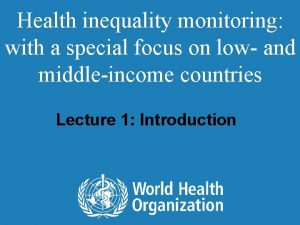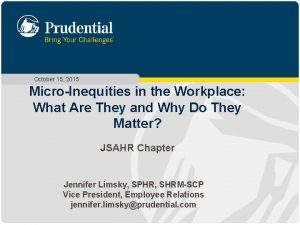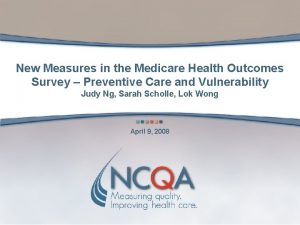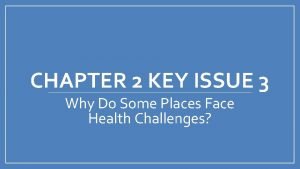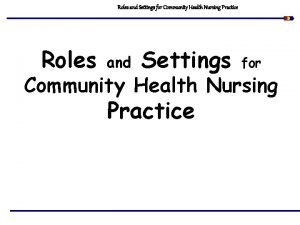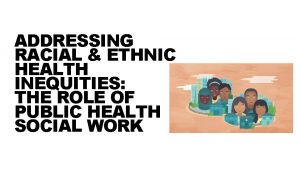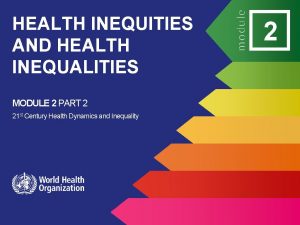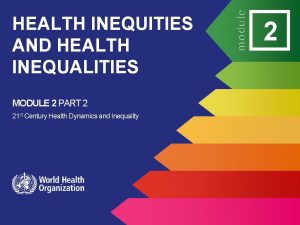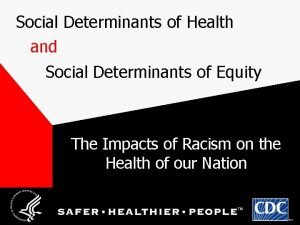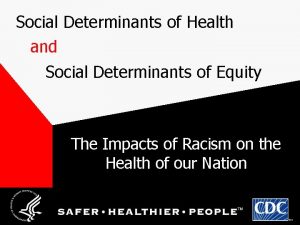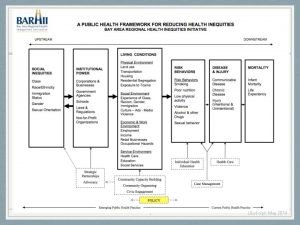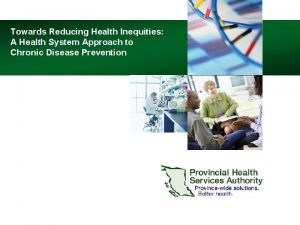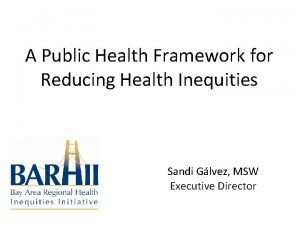POPULATION HEALTH Determinants Outcomes Inequities and the Role


















- Slides: 18

POPULATION HEALTH Determinants, Outcomes, Inequities and the Role of Targeted Universalism


KEY THEMES ❏ Population Health ❏ The determinants of health--both natural and social (or structural) ❏ How we move forward collaboratively to implement strategies to counteract impediments that continue to undermine the health of our population.

DEFINING POPULATION HEALTH

POPULATION HEALTH IS IMPORTANT AT ALL LEVELS ❏ At all levels, unhealthy communities negatively affects our economy ❏ economic viability begins with healthy neighborhoods ❏ At all levels, unhealthy communities result in higher healthcare costs for providers, payers, and communities; lower educational performance; and diminished productivity generally.

HOW DO WE DETERMINE POPULATION HEALTH?

NATURAL DETERMINANTS ❏ Genetics ❏ Infant mortality rate ❏ Stress ❏ Average Life Expectancy

SOCIAL/STRUCTURAL DETERMINANTS

More Equality is Good for Our Health “We also found that living in a more equal place benefited everybody, not just the poor… Likewise, the benefits of greater equality spread right across society, improving health for everyone – not just those at the bottom. In other words, at almost any level of income, it’s better to live in a more equal place. ” Wilkinson, Richard; Pickett, Kate

BREAKING DOWN THE PERCENTAGES ❏ How much of our health status is determined by biology? ❏ How much of our health status is socially/structurally determine? ❏ Health status is determined by: (1) genetics: 20 -30%; (2) health-care: 10%; social, environmental conditions, and behavior: 6070%




CURRENT STATE OF HEALTH OUTCOMES ❏ Detroit’s health outcomes lags substantially behind Michigan and most of the nation. ❏ In 2010, Detroit’s rates for congestive heart failure, asthma, diabetes, and grand mal and other epileptic conditions were more than twice that of the State of Michigan. ❏ Within Detroit, there are 3 areas of greatest concerns--south of I-75, immediately west of Woodward, and immediately east of Woodward. These areas have Ambulatory Care Sensitive (ACS) discharge rates of 500 or more per 10, 000 residents, greater than twice the rate of the State of Michigan.

CURRENT STATE OF HEALTH INEQUITY i. Lack of access to healthcare, appropriate care, and under-utilization of available services. ii. Social and Structural determinants continue to remain a barrier to improved health outcomes. ● 89% of Detroit’s population live in a Medically Underserved Area (MUA) and 81% of the Detroit population is classified as living in a Health Professional Shortage Area (HRSA). ● Detroit’s unemployment rate continues to exceed that of Michigan and the U. S. ● Detroit officials project that the demand for food assistance will increase substantially, while resources necessary for providing such assistance are expected to decrease.

WHAT IS OUR AIM MOVING FORWARD? Turn This: Into This:

COMPARING APPROACHES TOWARD A HEALTHIER FUTURE ❏ Universalist Approach ❏ Applies to everyone; treats everyone the same. ❏ Targeted Approach ❏ Applies to particular populations and treats only those populations. ❏ Targeted Universalism Approach ❏ Sets universal goals for everyone, while targeting populations to help specific groups.

CLOSING REMARKS While we look at health inequities and the social determinants of health, our goal is improving the health of the entire population, not just achieving equity for disenfranchised groups who may live in disenfranchised areas. The future of Detroit is linked to the future of Southeast Michigan, the future of our individual communities is linked to the future of the U. S. , and the future of the U. S. is linked to the future of the world.
 Inequities vs inequalities
Inequities vs inequalities Micro inequity exercises
Micro inequity exercises Role of community health nurse in occupational health
Role of community health nurse in occupational health What are the 6 main social determinants of health?
What are the 6 main social determinants of health? Physical environment determinants of health
Physical environment determinants of health Medicare health outcomes survey
Medicare health outcomes survey Worker role azure
Worker role azure Population ecology section 1 population dynamics answer key
Population ecology section 1 population dynamics answer key Section 1 population dynamics answer key
Section 1 population dynamics answer key Population ecology section 1 population dynamics
Population ecology section 1 population dynamics Population ecology section 1 population dynamics answer key
Population ecology section 1 population dynamics answer key Soziale identität krappmann
Soziale identität krappmann Statuses and their related roles determine the structure
Statuses and their related roles determine the structure Population health risk assessment and management
Population health risk assessment and management Chapter 2 population and health key issue 3
Chapter 2 population and health key issue 3 Community health nursing function
Community health nursing function 3x2 matrix
3x2 matrix Applications of matrices and determinants
Applications of matrices and determinants What factors affect personality
What factors affect personality
